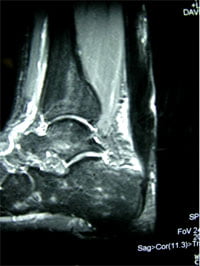Introduction
Tendonitis is a term that means inflammation or swelling, and it occurs often in and around the Achilles.
There are two areas of the Achilles prone to this problem: in the middle of the tendon (mid-substance Achilles tendonitis) and at its insertion into the heel bone (insertional Achilles tendonitis).
Patients with tendonitis within the heel and Achilles, may be seen in our Heel Pain Clinic where they can normally have an assessment, imaging, decision and first treatment within a single, first clinic visit.
Achilles Tendonitis Symptoms
Insertional tendonitis is seen in runners, but also in individuals with a certain shape of heel bone. It presents with pain right at the back of the heel. In both forms of tendonitis the pain is often worst first thing in the morning and after periods of rest, so-called “start up” pain. Once the individual has “warmed up” the symptoms often improve but shoes can be very bothersome where the shoe rubs on the sore area.


Causes Achilles Tendonitis
Mid-substance tendonitis presents as a painful swelling of the tendon and is often seen in long-distance runners. However, it can follow unaccustomed activity or after a minor injury and rarely in the elderly after taking certain antibiotics (Fluoroquinolones).
Diagnosis for Achilles Tendonitis


Diagnosis of tendonitis is based on the symptoms you are having and a physical examination. If the tendonitis has caused the greasy liquid that protects the tendon to become dry, this can be heard through a stethoscope because of the friction inside the affected area.
Any calcium deposits in the tendon or the surrounding sheath can sometimes be seen on an x-ray. An ultrasound or an MRI scan may be required to detect the condition.
Achilles Tendonitis Treatment
In many people, the condition will improve with time (12–18 months), anti-inflammatory medication, activity and footwear modification but the mainstay of treatment is physiotherapy.




